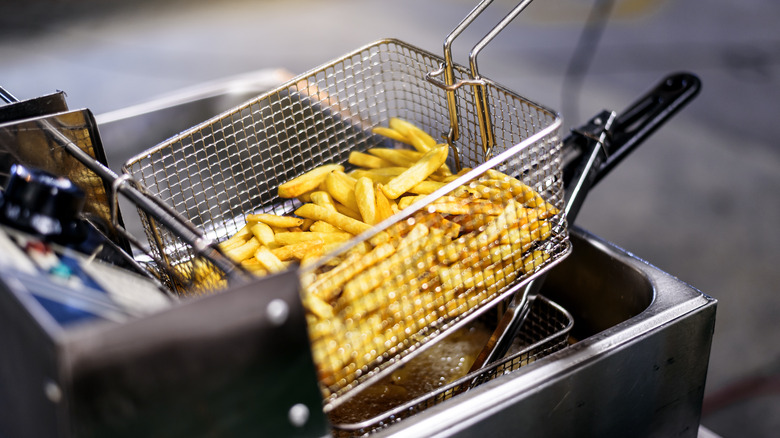Jet Tila's Tips For Making Perfect French Fries
French fries are one of those foods that are easy to make, but difficult to master. Anyone can cut up some potatoes and crisp them in oil, but getting them to be restaurant quality is a whole different story. Just one misstep, and you might end up with greasy, wet sticks of mushy mashed potato or unfortunate wedges that are burnt on the outside, yet undercooked on the inside. There are all sorts of ways you can fry potatoes, be it with a deep fryer or air fryer, but how exactly does the process work? What happens to the potatoes during the cooking that renders them a crispy, fluffy snack instead of a pile of soggy spuds that are better off in the compost heap?
Fortunately for fry fans all over, celebrity chef Jet Tila and food scientist Dr. Arielle Johnson broke down the science behind these humble tuber treats on Popular Science, and their findings are full of tips to ensure that your french fries are crispy, golden brown, and pillowy soft every time.
The key is not one, but two stages of frying
In a video by Popular Science, Tila demonstrates the perfect french fry recipe while Dr. Johnson gives scientific commentary on each step. Tila begins by soaking a handful of ¼-inch to ½-inch wedges of clean, skin-on russet potatoes in cold water. This is done to remove excess starches within the tuber, as they can cause the fries to stick together and lose their crispiness during cooking, Dr. Johnson explains.
Tila pats the potatoes dry and heats a deep pot of oil to 325 degrees Fahrenheit for the first stage of frying. After five minutes of cooking, the fries are pale and floppy, but this is good: This initial round causes starch gelatinization, which means the tightly packed starches in the potatoes soften and yield a fluffy mouthfeel inside each fry.
For the second stage of frying, Tila bumps up the oil to 375 degrees and cooks the potatoes for five to 10 more minutes until golden brown. This second, higher-temperature round of frying dehydrates the surface of the fry, allowing the starches on the exterior to become crisp, Dr. Johnson explains. You'll know it's working when you see lots of bubbles in the oil; that's the water leaving the potatoes. Additionally, this step spurs the Maillard reaction, in which sugars and amino acids caramelize at a high temperature and grace the fry with its toasty flavor and golden color. All that's left to do now is to season the fries to your liking, enjoy them while they're hot, and remember this handy lesson the next time you want to fry some spuds.

